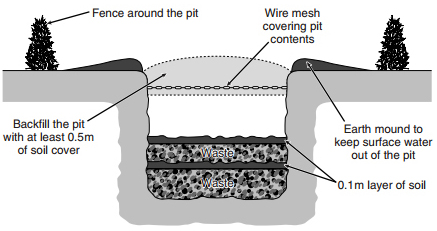14.4.4 Solid waste management in emergencies
The safe disposal of solid waste is critical for public health, especially during an emergency. Not only will existing solid waste collection and disposal systems be disrupted but there will be extra waste caused by the emergency itself. Initially at temporary settlements for displaced people or refugees there will be no arrangements in place at all for solid waste management. If solid waste is not dealt with quickly, serious health risks will develop, which may further demoralise the displaced community already traumatised by the emergency.
If organic solid wastes (such as food waste) are not managed properly, there are major risks of fly and rodent infestation (particularly rats) and surface water pollution. Solid waste often blocks drainage channels and leads to environmental health problems associated with stagnant and polluted surface water that can lead to drinking water contamination. Uncollected and accumulating solid waste and the debris left after an emergency, natural disaster or conflict may also create a depressing and ugly environment, discouraging efforts to improve other aspects of environmental health.
The Sphere standard for solid waste management aims to ensure that ‘the affected population has an environment not littered by solid waste, including medical waste, and has the means to dispose of their domestic waste conveniently and effectively’ (Sphere Project, 2011).The key indicators in the Sphere standards include specific requirements such as ‘all households have access to refuse containers which are emptied twice a week at minimum and are no more than 100 m from a communal refuse pit’.
At a temporary settlement site, routines for the storage, collection and the disposal of solid waste or refuse need to be implemented and resourced. This is particularly important at high density sites. Engaging the community can be a vital aspect and any initial clean-up operation should be community based.
A common way to produce storage containers is to use 200-litre drums that can be cut in half to give two 100-litre drums. Drainage holes should be drilled in the bottom. UNHCR suggest that these drums should be placed throughout the site so that no household is more than 15 m away from one (UNHCR, 2007).
Collection from site containers should be done regularly (daily if possible). Lorry or tractor and trailer-based collections can be expensive. It may be more appropriate to use hand carts, wheelbarrows or donkey-pulled carts if available.
The options for treatment and disposal of solid waste in emergency situations are similar to the standard methods that you learned about in Study Session 10. Open dumping should be avoided because of the health risks for people and animals. Burning of solid waste is possible although it creates the problem of smoke and will not achieve a sufficiently high temperature unless a purpose-built incinerator is used. The most likely disposal method is burial. If it is possible to do so, existing waste disposal sites should continue to be used. For temporary settlements, areas should be designated for burying waste and they should be well away from households and fenced off. If waste is to be buried on-site in either household or communal pits, it should be covered daily with a thin layer of earth to prevent it attracting vectors such as flies and rodents. Figure 14.4 shows the main features of a solid waste burial pit.

Briefly outline why standards are important in the management of emergencies.
They set a benchmark of targets to achieve and maintain. They are universally accepted as good practice and can help the planning of resources and preparation for emergencies.
14.4.3 Handwashing and hygiene
